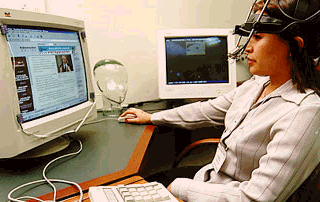 This eye tracking technology is just fantastic. There are lots of companies selling this service and for good reason (just look at the sponsored links when searching for eye tracking). I wish I could afford this for the Google Challenge (i.e. for optimizing the landing page)!
This eye tracking technology is just fantastic. There are lots of companies selling this service and for good reason (just look at the sponsored links when searching for eye tracking). I wish I could afford this for the Google Challenge (i.e. for optimizing the landing page)!It is, on the other hand, quite worrying if you are using AdWords. Take a look at the video below (from Google's Official blog). It seems that nobody looks at the right column of advertisements. I bet we can catch some of it with our peripheral vision, though. But I guess the lesson here is to bid high in AdWords because you want to be on top of the organic search. That's where the gold is.
I found yet another interesting study by Think Eyetracking suggesting that users are getting used to Google results. The image below is a heat map of eye movements on a Google result. Users are getting smarter and more efficient with time. How does it affect the internet marketers? We have less and less time to catch the user's attention. And again: bid high on AdWords!
Any other suggestion?




